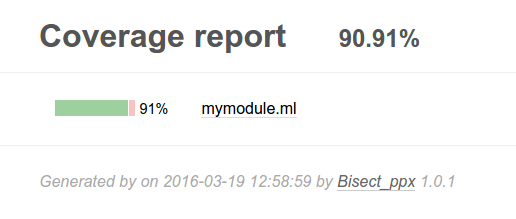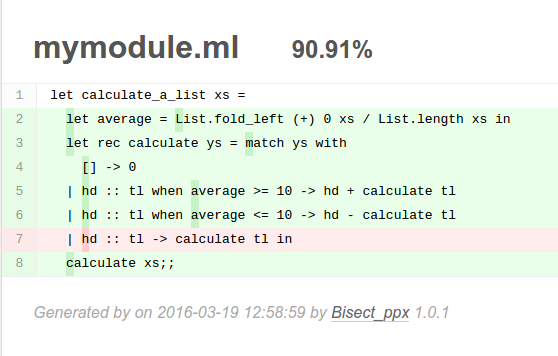A 100% test coverage should be a goal for every project
Update
I made this assertion to test the validity of this idea, now I no longer believe a 100% test coverage is a good idea, mainly because this measure can be deceiving, instead you should make sure to test all corner cases.
Maybe I’m making a bold conclusion, however I think a 100% test coverage should be a goal for every project, specially when working with dynamic languages. Now, I don’t mean the whole project should be covered, but the code you manually type; that will exclude the logs, temps, autogenerated code, even config files.
As every tool developers use you should be able to configure your coverage tool so you can include only the pieces you need to test. Of course, this metric is not the only one we can use to make sure our code is safely tested, but I think is a good one.
I’ve been reading a few posts negating the efficiency of TDD, like Dubious Decisions: Passing on TDD and Giving up on test-first development. I can’t agree more on that. I’m not sure if this has been stated before (as a methodology), but what I do is the next:
- Write code.
- Write test.
- Check code coverage.
So, if I don’t feel satisfied with the coverage percentage, I write more tests accordingly.
However using only test coverage is not enough, there are some flaws that I will show, I’ll be using Ocaml as an example (disclaimer: I’m not really an Ocaml developer, I just think the language is cool). First, lets say we want to write a function that sums two numbers, we can write it this way:
mymodule.ml
let sum_two_numbers first second = first + secondSimple, right?, now we’re going to create the unit test using OUnit:
test.ml
open OUnit2;;
let test1 sum_two_numbers_test = assert_equal 121 (Mymodule.sum_two_numbers 54 67);;
let suite =
"suite">:::
["test1">:: test1]
;;
let () =
run_test_tt_main suite
;;We need a coverage tool and looks like bisect is the most popular one, so we’ll be using that, for this example we’ll be using a fork named bisect_ppx. So, we just need to type in the command line the next:
ocamlfind c -package bisect_ppx -c mymodule.ml
ocamlfind c -package oUnit -c test.ml
ocamlfind c -linkpkg -package bisect_ppx -package oUnit mymodule.cmo test.cmo
./a.out
bisect-ppx-report -I build/ -html coverage/ bisect*.outNow, you can open coverage/index.html, and see a shiny coverage report for our code.

So, we decided our module is ready to use and test it in a repl, we open utop and type:

As we can see our function does not accept float numbers, only integers. If we want to fix that, we can add another function just for floats or rename the function we’re using like sum_two_integers.
What if we want to make a fancy calculation of a list of numbers:
let calculate_a_list xs =
let average = List.fold_left (+) 0 xs / List.length xs in
let rec calculate ys = match ys with
[] -> 0
| hd :: tl when average >= 10 -> hd + calculate tl
| hd :: tl when average <= 10 -> hd - calculate tl
| hd :: tl -> calculate tl in
calculate xs;;I’m calculating a list to sum it if its average is bigger than 10, and subtract it if its average is less than 10. Then we write the test:
open OUnit2;;
let test1 calculate_a_list_test = assert_equal 184 (Mymodule.calculate_a_list [54; 32; 98]);;
let test2 calculate_a_list_test = assert_equal 3 (Mymodule.calculate_a_list [1; 2; 3; 4; 5]);;
let suite =
"suite">:::
["test1">:: test1;
"test2">:: test2]
;;
let () =
run_test_tt_main suite
;;We run the previous commands and get the next coverage report.


Now, we think to ourselves that we really don’t need to cover that last match, in the end if the average is less than 10 we are covered and if it’s bigger we are covered as well, we just include it to stop the exhaustive warning in the pattern matching the compiler is giving us. So, we decided to ignore it like this:
let calculate_a_list xs =
let average = List.fold_left (+) 0 xs / List.length xs in
let rec calculate ys = match ys with
[] -> 0
| hd :: tl when average >= 10 -> hd + calculate tl
| hd :: tl when average <= 10 -> hd - calculate tl
| hd :: tl -> calculate tl in (*BISECT-IGNORE*)
calculate xs;;We finally have our 100% test coverage.
Conclusion
I think you should achieve a 100% test coverage for your project, it’s up to you to decide how you configure your coverage tool so you can meet that goal. It’s not a silver bullet, but at least you know your app will work in the best case scenario when you’re showing it to a client or to your boss.
This is just my opinion, if you disagree I’d like to know.